Saucon Valley Country Club
by Peter McKnight
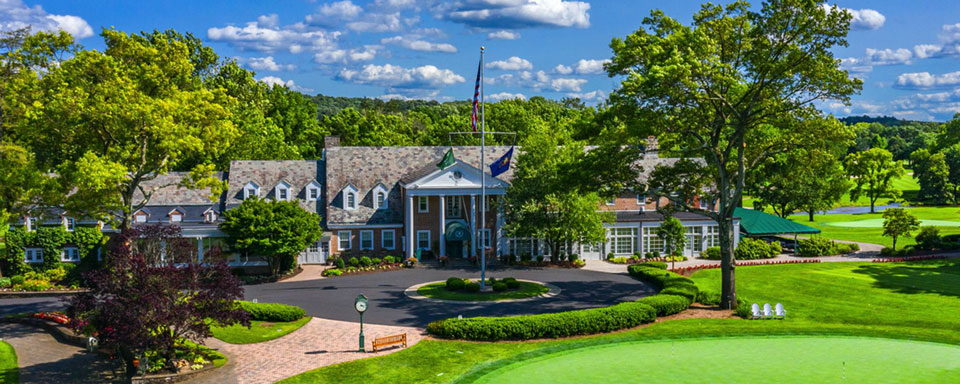
SVCC Clubhouse front with the putting green in the foreground. The Old Course’s first hole is to the left, while the newly arranged tenth hole is to the right of the putting green. Photo courtesy of Discovering Lehigh Valley 2022 US Senior Open.
Saucon Valley Country Club
Bethlehem, Pennsylvania
www.sauconvalleycc.org
Club centennial 1920-2020; golf centennial 1922-2022
Certified Audobon Cooperative Sanctuary
THE OLD COURSE (7,129 yards, par 71)
Herbert Strong 1922, Perry Maxwell 1941, Tom Fazio 2008
(Eugene Grace through the years)
THE GRACE COURSE (7,091 yards, par 72)
William and David Gordon 1953 (holes 1-6, 16-18)
William and David Gordon 1957 (holes 7-15), officially 18 holes 1958
Andrew Green 2014
THE WEYHILL COURSE (7,099 yards, par 72)
William and David Gordon 1968
Tom Fazio 2010
Mike Wood, Director of Golf
Jim Roney, Director of Golf Courses and Grounds
Prologue
One could consider Saucon Valley Country Club one of the finest country clubs in the United States. In addition to three championship courses, the club has several Har-Tru tennis courts, an Olympic-sized swimming pool (which is located behind the clubhouse and between the 9th and 10th holes on the Old Course), an indoor practice facility at the squash court facility and two indoor tennis courts and paddle tennis courts by the Shoudy Barn. It was Eugene Grace’s vision (former president of Bethlehem Steel) to create such an establishment in and for the Lehigh Valley.
In October 1920, the Lehigh County Court gave Grace and 16 other business leaders the authority to transform 205 acres (today, the Club comprises 850 acres) of farmland near Saucon Creek into ‘golf links and other facilities for athletic sports.’ Grace chose Herbert Strong to design the first course in SVCC’s arsenal of courses. The course opened for play in 1922 and largely remains intact, although Perry Maxwell, William Gordon, Tom Fazio (through Tom Marzloff), and Eugene Grace have made revisions to the course since it opened for play.
In 1953, SVCC, through the leadership of Grace, decided to build another course. The Club hired the design team of William and David Gordon to build what is now known as the Grace Course. This course was built in stages: The first nine holes (1-6, 16-18 on the current routing) were built in 1953, while the rest of the course (7-15) was finished in 1957. The course officially opened in 1958. During the construction of the Grace Course, the Gordons’ also built the Short Course, a six-hole course for the club’s juniors and beginners. This course is located at the club’s Saucon Valley Road entrance.
In 1968, Bethlehem Steel finished the construction on the Weyhill Club course, designed by William and David Gordon. The property used to be a large family farm with very few country estates surrounding it. Today, it is an exclusive neighborhood with sizeable estates. Originally, the facility was owned by Bethlehem Steel, managed by SVCC, and possessed its caddie pool. The Weyhill Club course was also the only course at SVCC without names for the holes (until fifteen years or so ago). Of all three courses, it experiences the least amount of play throughout a playing year. It possesses, however, the most dramatic land available along Saucon Creek. For years, the executive chef Jack made the best hamburgers in the nation. I give the USGA and SVCC a great deal of credit for selecting the Weyhill course as the 2014 USGA Mid-Amateur companion course over The Grace course.
I caddied at SVCC for seven years between 1985 and 1992. I will always consider SVCC my home course since many of my formative years were spent there in some capacity or other. I have personally have seen every inch of each of the three golf courses either by caddying or by my play. Caddies can play one of the three courses (usually the Grace or Weyhill course) on Mondays between 0900 and 1300. If you could not play 27 holes in 4 hours, you were considered slow. The older caddies would specifically hit into you if they felt you were playing slow. Back then, we had to wear trousers to play!
The first head professional was Robert D. Thompson, who was hired in 1922. His assistant was Ted Polden, an excellent club maker, who in turn became the head professional from 1927 until 1935. In August of that year, the legendary Ralph Hutchison became the third head golf professional at SVCC. During most of the last half of the 20th century, the head golf professional was Jerry Pittman, who was also the head golf professional at world-renowned Seminole Golf Club. However, the most revered teacher at SVCC was Morry Holland, who has assisted so many players at SVCC to become better players. I can still vividly see him drinking a few cold ones after another day of major swing surgery.
Tournament History at Saucon Valley Country Club
OLD COURSE
1951 USGA AMATEUR: Billy Maxwell d Joseph Gagliardi 4 and 3
1960 Pennsylvania Senior Amateur Championship: Egon Quittner (no score available)
1975 Pennsylvania Senior Amateur Championship: Russ Maitland 159
1980 Pennsylvania Senior Amateur Championship: Joseph Durante 150 (The Grace Course hosted the other round)
1983 USGA JUNIOR AMATEUR: Tim Straub d John Mahon 1 hole
1987 USGA SENIOR AMATEUR (6,445 yards, par 71): John Richardson (medalist, 71-74-145) d James Kite 5 and 4
1992 USGA SENIOR OPEN (6,700 yards, par 71): Larry Laoretti 275 (68-72-67-68). This was Laoretti’s only Senior Tour win in his career. Stroke average 74.72.
2000 USGA SENIOR OPEN (6,749 yards, par 71): Hale Irwin 267 (66-71-65-65), which was the then tournament record. Stroke average 74.10.
2004 Pennsylvania Senior Amateur Championship): Paul Schlachter 144 (68-76)
2009 USGA WOMEN’S OPEN (6,740 yards, par 71): Eun Hee Ji 284 (71-72-70-71). Ji birdied the 18th to win by one shot. The final round played at 6,303 yards, par 71. It was the last Women’s Open won with a level par or higher final return to date.
2013 Pennsylvania State Amateur Championship (6,885, 6,990 and 7,070 yards, par 71): Christopher Ault 213 (76-70-67)
2014 USGA Mid-Amateur Championship (Old 7,091 yards, par 71, Weyhill 7,054 yards, par 71): Scott Harvey (co-medalist 65-76, 141) d Brad Nurski (co-medalist 71-70, 141) 6 and 5. Harvey’s 65 became the new competitive course record on The Old Course. Both courses averaged over 77.00 for the stroke-play portion of the tournament.
2016 Pennsylvania Women’s Amateur/Senior Amateur: Alessandra Liu (Amateur), Beth Ward (Senior Amateur)
2022 USGA Senior Open Championship (7,028 yards, par 71): TBD
GRACE COURSE
1987 Pennsylvania Open (7,051 yards, par 72): Brian Kelly 140 (67-73)
1998 Pennsylvania Middle Amateur Championship (7,051 yards, par 72): Andy Thompson d Chris Sekella 2 holes
WEYHILL COURSE
2018 Pennsylvania Middle Amateur Championship (6,894 yards, par 72): Matthew Mattare 66 (event shortened to one round due to rain; Mattare is a member at SVCC and his father was previously the Director of Golf)
The following descriptions of each course include the names of each of the holes, current back yardage, and the ability to add yardage if necessary for tournament conditions. A few points to make before describing the three courses:
- For the Old Course 2022, the Club has re-routed the back nine on the club’s scorecard to that seen in tournament conditions. That means no. 13 becomes no. 10 and the course finishes on the original no. 12.
- The Old Course will become the first course to host three US Senior Opens this June.
- There has been no change in the ordering on the Grace Course throughout the years. Furthermore, there’s no amendment to the original routing that would make any sense whatsoever. Of the three courses, the Grace is the only one whose 9th hole does not return to the clubhouse; rather it concludes at the Villa Pazetti.
- For the Weyhill Course, the Club re-routed the course from the original 1968 design. Today, it opens on the original 11th hole and ends on the original 8th. When the USGA conducted the 2014 US Mid-Amateur, they utilized the original rotation and played the 10th as a par four.
- For the longest time, the Club did not name the holes at Weyhill; that was amended around fifteen years ago. I have included my original names so you can compare and/or contrast them, etc. Additionally, it has its own crest, which includes a steel I beam, indicating the previous relationship with Bethlehem Steel.
- At Weyhill, there is now a Guest House there for the membership and national members. National members did not exist until very recently.
- There are various reasons why a US Open and/or a PGA Championship will never be conducted at SVCC, which will be explored through the narrative text. In short, in my opinion, it’s become a numbers issue inside the ropes.
- The prevailing breeze is as follows:
- Old Course: No. 1 downwind; no. 2 into the wind;
- Grace Course: No. 1 into the wind; no. 18 downwind;
- Weyhill Course: No. 1 original into the wind; no. 9 original downwind.
- Flag colours:
- Old Course: Yellow;
- Grace Course: Brown;
- Weyhill Course: Red.
- Both Lehigh and Moravian utilize SVCC as their home courses for their respective golf teams.
- The late Chuck Bednarik was the first “celebrity” member of SVCC and had the heaviest bag in the membership.
- There is one caddy from SVCC in the Caddy Hall of Fame—Cotton Young. When I caddied there, his number was three from the days when caddies were assigned numbers. He always went out first when I was there.
Old Course Description
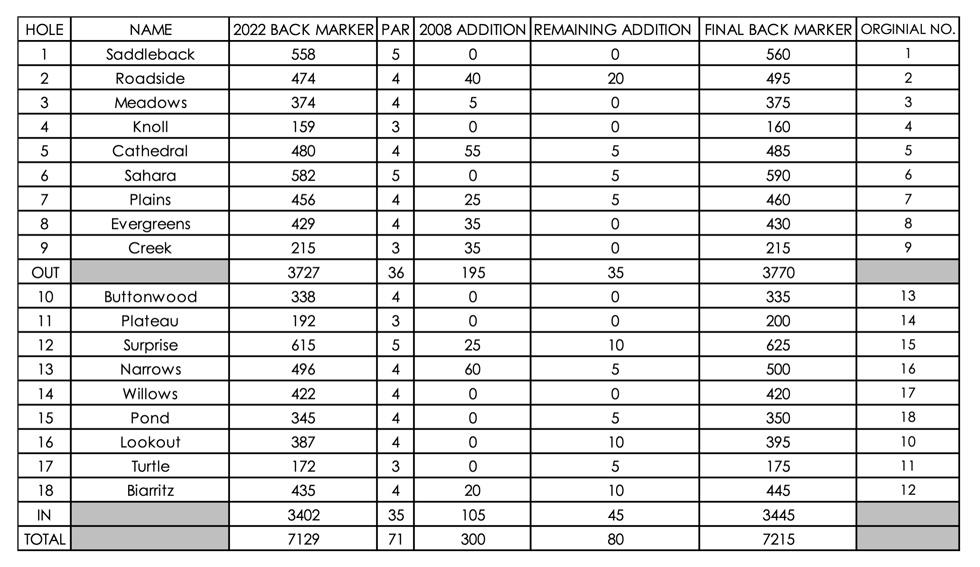
Hole 1: Saddleback: The tee is right in front of the stately clubhouse, a short walk from the men’s locker room. One must hit the opening tee shot quite long to approach the saddleback in the fairway about 290 yards from the tee. The second shot is usually semi-blind down the hill to a reasonably flat landing area about 80-110 yards from the green. This green, however, is not the original green as designed by Strong, as the green was redesigned and pushed back 40 yards before the 51st Amateur. The most difficult hole location positions are on the right side over the front right bunker where the green has the most pitch. The green loses its pitch as the player goes back and left. This hole could be converted into a par four at 510 yards, which in my estimation, would make it the second hardest opening hole in Pennsylvania behind Oakmont.
Hole 2: Roadside: This hole is perhaps the strongest par 4 hole on the Old Course. The hole parallels the Saucon Valley Road entrance road to the club. Again, the drive must carry a much-reduced saddleback in the fairway (compared to no. 1) to hit a mid-iron from a level lie into a severely undulating green. The most difficult hole location is back left, although any hole location in the back is difficult. There remain another twenty yards to move the back tee, which would place it near the 5th hole on the Short course. The second hole remains the only hole on the Old Course where there’s room to lengthen rather than a mere tweak.
Hole 3: Meadows: The tee shot on the 3d hole must be threaded through a funnel created by mounds protecting players going to the rock pile, the caddy shack, and the main parking lot. There are trees on both sides of the fairway. Caddies forecaddy on this hole on the other side of the mounds near the tree line by the parking lot. I remember during my caddy days that all caddies would kick balls out of the right tree line to help speed up play. The hole takes its name after a large meadow on the extreme left behind the rock pile. The second shot is played with a short iron over Saucon Creek (the first shot over the Creek) to perhaps the most sloped green on the Old Course. The green has two levels, with the lower level sloped enough to allow overspun second shots to screw back into Saucon Creek (a significant change from the original design). The toughest hole location is in the back, just over the ridge.
Hole 4: Knoll: This is the first hole in my playing life I played from the back tees. I didn’t feel like walking to the middle tee so I placed a ball down at the back tee, hit an 8 iron to 15 feet, and decided to play from the back from then on. The hole itself is only troublesome if the hole location is on the top shelf, back right. Otherwise, with a wedge or 9 iron, not much is asked of a player. For about two years in the 1980s, the sand was so soft in the front (deep) bunker that balls would disappear in the front face. If the club were ever to institute closely mown chipping areas, shaving the bank on the right would be great. Certainly a breather hole.
Hole 5: Cathedral: This is my favorite par 4 on the Old Course. I believe the hole got its name from the stately nature of the hole’s design. The tee shot must be hit straight between two fairway bunkers to leave a mid-iron into a long and severe green. The second shot is hit to a green surrounded by trees on all sides and an OB fence on the left. The green is perhaps the subtlest green on the course, with the most difficult hole located mid-center and left. The hole gained additional yardage after the 2000 US Senior Open because Bruce Fleischer, for example, hit driver, wedge here in the 2000 US Senior Open and that certainly was never the original intent of the hole’s design.
Hole 6: Sahara: This hole runs gently uphill all the way until the 165-yard mark. The fairway is wide open for a fade or draw. The second shot must contend with the expansive sand area known as the Sahara. The Sahara is on the right and is littered with small shrubs (and, yes, caddies have to rake it). The third shot is usually a wedge to a moderate-sized green with a deep pot bunker front and center. The toughest hole location position is right behind the pot bunker. This is the number one stroke hole for the members, although it played the easiest of all the holes in the 1992 and 2000 US Senior Opens.
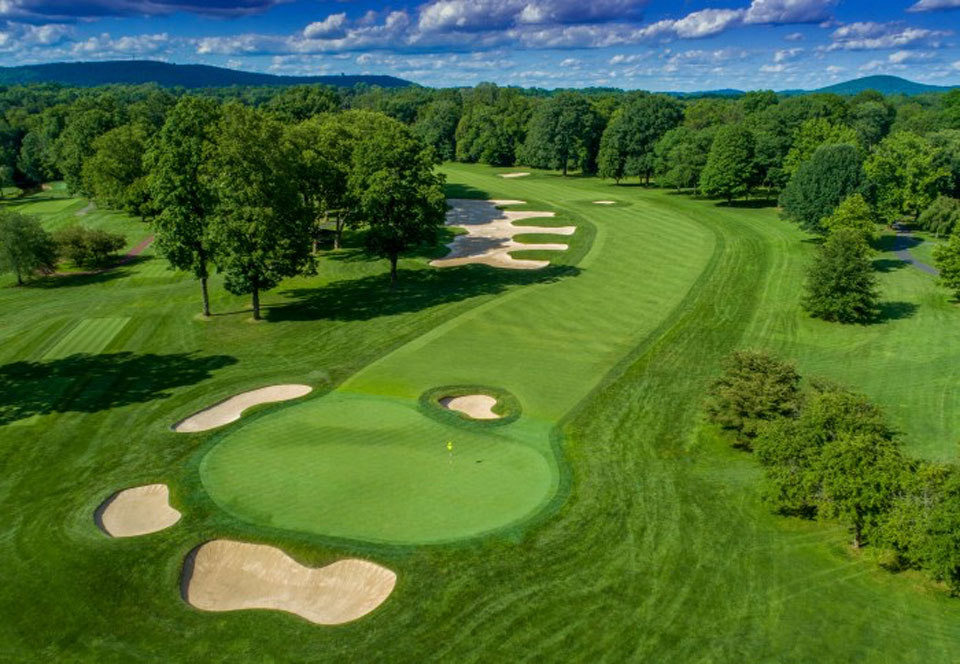
The view behind the Old Course’s sixth hole, the Sahara. Photo courtesy of USGA Fred Vuich.
Hole 7: Plains: This hole parallels the 16th on the Grace Course and is on some of the levelest land on the course (and amongst the highest elevation on the property). The drive must thread through a set of bunkers to reach the plains and set up a mid to short iron into a moderately sized green. There is a hogback that runs across the heart of the green, making back hole locations more difficult. Again, length is necessary for tournament play because the green was designed for a mid-iron, not 8 and 9 irons.
Hole 8: Evergreens: This hole is reasonably hard against the club’s Shoudy barn entrance road and one can see the 6th tee and the 18th hole on the Grace Course from the tee. The tee shot must be drawn around the bunker in the left corner of the dogleg to set up a wedge approach. Before the 1992 and 2000 US Senior Opens, a great deal of the green was recaptured behind and to the right of the right front bunker, green that had been lost over years. It added about another hole location position or two to the green and brought the right bunker into play. The toughest hole locations are on the right side. Another closely mown chipping area would be good right and long. The length became necessary to make the fairway bunkers more relevant again.
Hole 9: Creek: This hole concludes the front nine and represents the second shot over Saucon Creek. The back tee has been relocated to a position below and left of the 8th green, thus lengthening the hole by thirty yards. Before the 2000 US Senior Open, the club recaptured some of the green over the right front bunker, adding another hole location. The green is rather large and moderately sloped from back to front. The toughest hole locations are on the right side. The club’s pro shop is just behind the green. Also, the 1980s scorecard version had this hole as the signature hole on the Old Course. There’s no question this hole presents quite the beautiful photograph.
Hole 10: Buttonwood: The tee is by the west dining room in the clubhouse and is on the opposite side of the putting green from the first tee. The tee shot is partially downhill to an uphill fairway surrounded by bunkers (none were part of the original design; they were added by Maxwell, Gordon, and Grace himself). There is a swale in the green that is not too severe and reasonably accepts a wedge shot. The hole earned its name from the trees framing the hole. A quite comfortable start to the back nine, which plays over 300 yards shorter than the front.
Hole 11: Plateau: This hole is the longest par 3 on the Old Course by far and plays entirely uphill. As a caddy, you wanted your golfer to at least make it up to the forecaddy area, otherwise, the walk down, then up the hill would be brutal. The green has two levels, which were more distinct before the 1992 US Senior Open. Expanding the closely mown chipping area in front of the green would allow balls to exit the green far quicker and leave a more difficult shot for a player not hitting the most precise shot into this green. I used to believe this green is the most severe given the shot required until the front half of the third hole went through its renovation before the 2009 US Women’s Open. The 4th hole on the Short Course is on the player’s right.
Hole 12: Surprise: This hole was featured in Golf Journal as one of their Great Golf Holes in 1992. The tee shot must be threaded through a tunnel of trees and makes one think it is similar to Congressional Blue no. 18. The drive must be played right to left to take advantage of the speed slot on the left side. The second shot must be played off a somewhat downhill lie and must avoid a rather large fairway bunker (in the fairway) about 125 yards short of the green. The third shot must be delicately placed to a much more relaxed version of the Turtle (see hole no. 17). The toughest hole location is back and right. From 15 yards short of the green and looking right, one can see the third hole on the Grace Course.
Hole 13: Narrows: This hole parallels the 17th on the Old Course and the 2d on the Grace Course. The hole is straight away with no bunkers. For the better player, the Saucon Creek doesn’t come into play (which is on the left side). The green is not all as severe as some of the others on the Old Course. During the 2008 renovation, the back tee moved back sixty yards to an area back and to the left of the 12th green where trees had been removed. Now, a player feels the pressure to hit his driver quite long to secure a par, something that didn’t necessarily exist from the previous 434-yard tee.
Hole 14: Willows: This hole parallels the first hole on the Grace Course and shares a teeing ground with the fifth on the Grace Course. Another right to left dog-leg tee shot that must avoid the willows on the left to open up the green. The second shot clears Saucon Creek some 50 yards short of the green to a semi-punchbowl green with moderate slopes. With some breeze (prevailing, down, and to the right), this tee shot is tough.
Hole 15: Pond (originally Saucon): The original back tee was shared with the middle tee on hole 16. The tee shot is not all that demanding to a flat fairway. The bunkers that dot the hole on the left of the fairway were not part of the original design, as the original design was to emulate the 18th on The Old Course and could be driven. The second shot is a wedge to a highly sloping, large green. It is best not to be above the hole here. This hole does not play as the 18th in professional tournaments because only about 500 people can watch play from behind the green and the fact that it is only 25 yards from the West Patio. This hole has essentially replaced the ninth as the de facto definitive hole at SVCC.
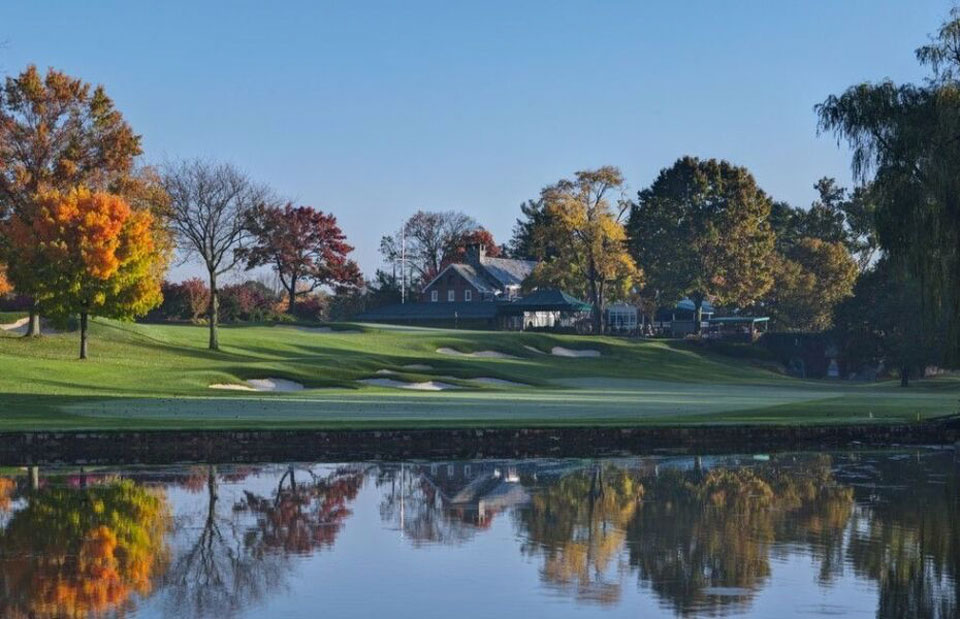
The quintessential and stunningly beautiful view from the Old Course’s fifteenth tee towards the West Patio. Previously, this hole concluded a round on the Old Course. Photo courtesy of Discovering Lehigh Valley 2022 US Senior Open.
Hole 16: Lookout: This hole was previously quite the difficult opening to the back nine, especially after the long walk between the 9th and 10th holes, which takes one by the club’s Olympic swimming pool. The tee shot must thread through bunkers left and right (the right side have been added in 1992 and 2000) to an upsloping fairway. The second shot is usually played from about 150 yards to a large back to front sloping green where a shot hit with too much spin will screw back 40-50 feet easily to the green’s front. In 1992, Larry Laoretti, on his way to winning the US Senior Open, fired right at the back left hole location to five feet for a birdie. The hole earned its name from the view from behind the green looking towards the clubhouse.
Hole 17: Turtle: This is my favorite par 3 at SVCC. The tee is elevated from the green and is hard against the snack shop. The shot itself is about an 8 iron to a green shaped like a turtle’s shell and surrounded by sand. It is the hardest green on the course to read. There is a flat shelf on the green middle to back on the left side that houses one of the most difficult hole locations on the course. As part of the recent renovation, trees that used to be hard behind the green have been removed, thus removing the backdrop that provided some visual clarity.
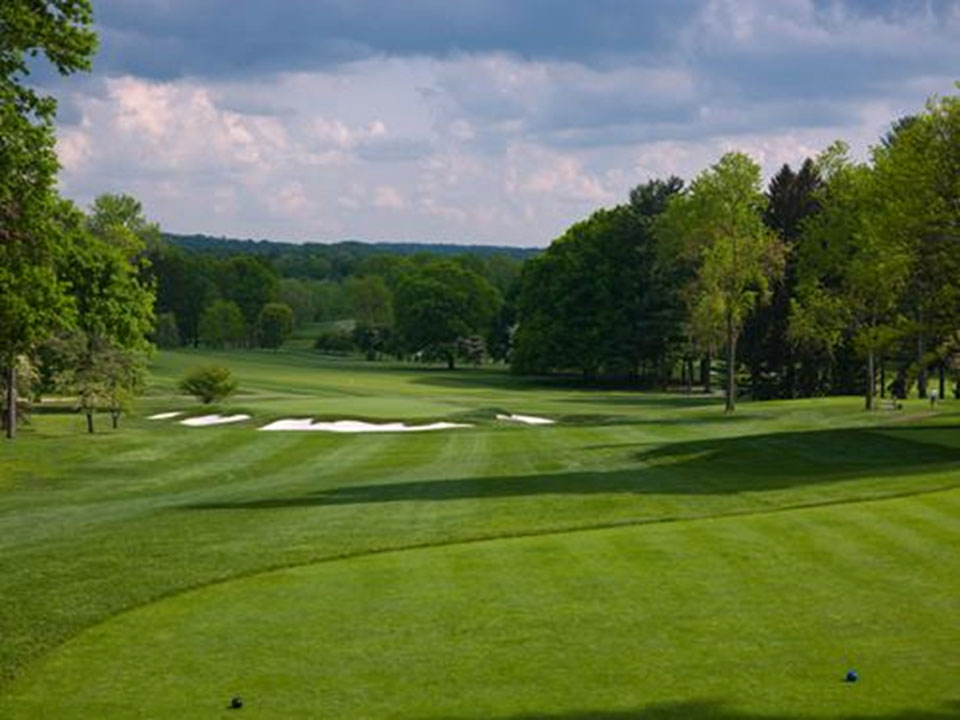
The Old Course number seventeen, the Turtle. My favourite par three at SVCC. There are no more trees assisting one line up the tee shot. Photo courtesy of Saucon Valley CC.
Hole 18: Biarritz: This hole is a true dogleg, continually bending from right to left almost to about 150 yards out from the green. The tee shot is downhill, sweeping rather dramatically from right to left. The second shot can be semi-blind, depending on what side of the fairway the player is. The green has characteristics of a Biarritz green but is nowhere near the structure of Yale 9. There is a swale that bisects the green about 40% into the green to a reasonably sloped upper tier. The toughest hole locations are in the back left of the green. Laoretti birdied here in 1992 to close out his fourth round, then was fly-tackled by his wife. Additionally, Ji birdied the 18th in the fourth round to win in 2009 after the USGA moved up the tee fifty yards from the first round.
In summary, the maximum total yardage for The Old Course is 7,215, with a par 70 set-up at 7,165 yards.
Grace Course
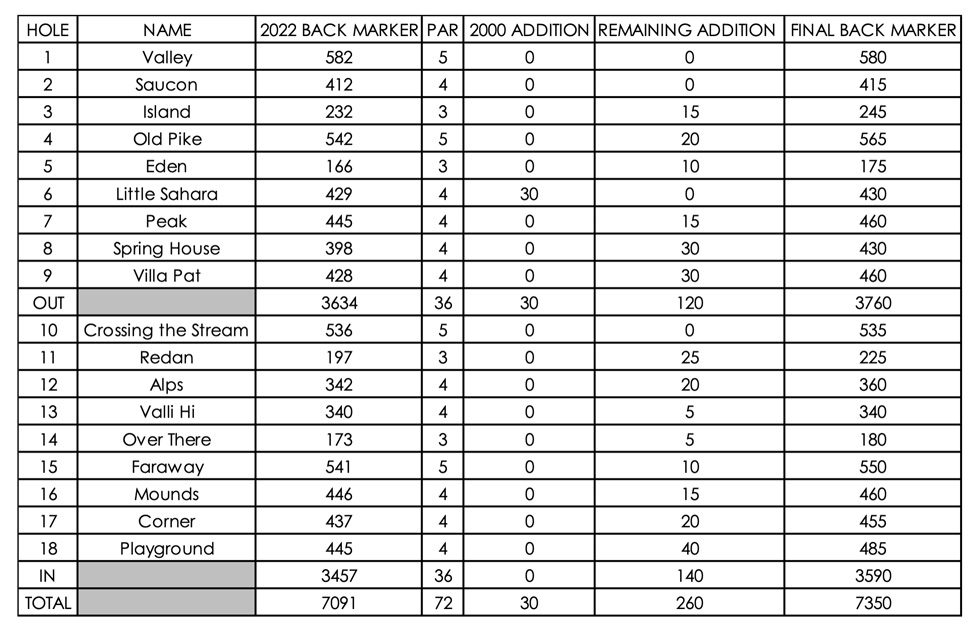
The first nine holes constructed on the Grace course had virtually unlimited land. The second nine holes constructed had far more limited land, especially in the area between holes 10 through 14. The shot values are slightly less than the Old Course, but there is a better finish, especially if Hole 15 is converted into a par 4. Unfortunately, the Grace Course will never be tested in competitive situations because of the 18th hole (more on that later). Additionally, there’s just no way of flipping the nines to finish on Grace no. 9. Also, converting two of the par 5s to par 4s would be less controversial here than on Old Course 1 (and less so because of technological issues with clubs and balls).
Hole 1: Valley: You approach the first hole on the Grace Course from the clubhouse area. When a player walks by the 18th hole on the Old Course to Grace Course 1, one understands the name of the hole (one goes from the high of the property to a low area). The hole is a double dog-leg (right, then left), ultimately bending to the right. There is not too much imagination necessary here. The green is one of the more sloped greens on the course. There is a cross bunker about 25 yards short of the green to create a visual effect. I have two stories about this hole. The first is that Larry Bell Snr (scratch), long-time club president, was attempting to qualify for the club championship one year. His first tee shot was a straight dive into Saucon Creek in front of the teeing area. He ultimately took 9, yet shot 76 with 17 straight pars. The other was when I caddied for Gary Daniels (club champion 1989, 1997, 2000, and played in the 2000 US Senior Open) during a practice round. He had 83 yards into the green and told him so. He thought it was 86. He hit it to 86 and was above the hole. He then hit it 83 (after walking it off) and put it 3 feet under the hole. That was my first glimpse of truly controlled golf. This hole parallels Grace no. 18 and Old no. 17. It’s the longest hole on the Grace Course.
Hole 2: Saucon: This hole parallels the Old’s 16th and is remarkably similar on the tee (just opposite directions). The second shot must clear Saucon Creek some 90 yards short of the green to a green with bunkers right and left. The green is reasonably large with subtle breaks. The rough here is usually some of the thickest because it is one of the low points on the property, receives the most sun, and seems to have an endless supply of water from the wetland/forest area on the left side.
Hole 3: Island: This hole’s tee (almost) abuts the Old’s 15th green area. It is the longest par 3 on the course and at SVCC. There is water about 40 yards short and to the right of the right bunker. If one pulls it greatly, Saucon Creek is also in play on the left side (although that shouldn’t happen to a single-digit handicapper). The hole usually plays into a crosswind. The green does not have a severe pitch and allows for a long iron to hold. It was on this hole I gave up trying to hit a 1-iron. This hole is probably the toughest par on the course. I have long wondered what would happen if the trees to the right of the teeing ground were eliminated and the tee shifted some twenty to thirty yards to the right. I believe it would make the hole perhaps the most difficult on the entire SVCC property.
Hole 4: Old Pike: This hole earns its name by paralleling the Old Philadelphia Pike. It is perhaps the easiest of the par 5s on the Grace Course. If this hole were converted to a par 4, the tree at the corner of the dog-leg would have to be removed (and, I think, would make for a better hole). Old Pike is also the only par 5 that is not a double dogleg. The drive must be drawn, which then allows a player to reach it in two. The green is moderately sloped and has a stand of trees behind and right of the green. To the left of the green is the teeing ground for Grace no. 2. As a par four, this hole would play at 510 yards.
Hole 5: Eden: This is the shortest par 3 on the Grace. The hole also shares its tee with the 17th on the Old. Supposedly, it’s modeled after The Old Course’s Eden. It is about an 8-iron, slightly uphill, to a reasonably severe green with a deep bunker in front. In terms of a pretty picture, this is certainly one. Something along the lines of Pinehurst no. 2 no. 9 could work here and take better advantage of the physical terrain short and behind the green to create closely mown chipping areas that would increase the shot value from the tee. There are ten more yards behind this green to make this happen.
Hole 6: Little Sahara: This hole takes its name after the 50×50 yard bunker guarding the front and left of the massive green. After one catches one’s breath after the walk from 5 green to 6 tee (you walk through the 18th teeing ground to get there), it requires a straight tee shot, then an 8 or 9 iron into a green broken up into quadrants without severe undulations. Don’t slice the tee shot or else it will find its way onto the Old Philadelphia Pike. Since 1980, this is the only hole on The Grace Course with a new tee ground addition (from 389 yards to 429 yards). The Grace’s 16th tee is directly behind this green. Near the teeing ground was the residence of Jerry Pittman when he was the head golf professional.
Hole 7: Peak: This hole is almost a 90-degree dog-leg from right to left. A sweeping draw is required from the tee, and using the edge of the bunker at the corner of the dogleg helps tremendously. The second shot is from about 165 to 175 yards to a smallish green with bunkers left and right. This green has some pitch to it and putting is not as easy as the previous hole. After playing this hole a few times, I finally learned I needed to play a draw to score better. Learning that draw helped me keep some rounds going while playing the Grace Course, in that this hole no longer was a guaranteed double bogey.
Hole 8: Spring House: This hole plays downhill on the tee shot towards a drainage pond about 150 yards short of the green. There is also a huge weeping willow on the right side of the drainage pond, which forces a player to hit his drive to the left of the fairway. The second shot is hit uphill to a relatively flat green that possesses little imagination. I believe adding some undulations to the green and placing the tee on the other side of the road leading to the Villa Pazetti would strengthen the hole. The hole earns its name from the little house to the right and near the drainage pond.
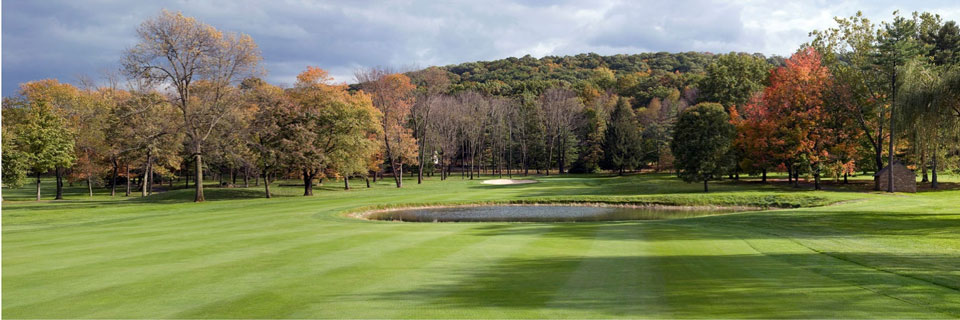
The Grace Course number eight. The Spring House is seen on the extreme right of the photograph. The photograph doesn’t do the second shot any justice, as it goes uphill. The ninth hole is to the left. Behind the green is the Old Philadelphia Pike. Photo courtesy of Stonehouse Golf Collection.
Hole 9: Villa Pat: This hole is one of the solid par 4s on the Grace Course. The tee is back in the trees and the tee shot asks a player to hit another draw to a fairway with a bunker on the left and Saucon Creek well on the right side. From an uphill lie, the second shot is hit to a moderately undulating green near the Villa Pazetti, the Grace’s halfway and private party house at SVCC. Bunkers surround the green. Placing the tee back some 30 yards would strengthen the value of the tee shot, as well as create perhaps the second hardest par four on the Grace Course.
Hole 10: Crossing the Stream: From Holes 10-14, this represents the most cramped section on the Grace Course. This hole was featured in either Golf Digest or Golf Magazine as one of the top 100 holes in the United States in the 1980s. As the name suggests, it is a par 5 where a player must cross Saucon Creek on the drive and on the second shot to set up a wedge approach to a reasonably pitched green. Essentially a three wood, 7 iron, and wedge get the job done on this hole. The only tough shot the player faces is placing the tee shot in the fairway, where there are trees on the left and trees and Saucon Creek on the right. The back tee is about 25 yards in front of the patio at the Villa Pazetti. In recent years, some of the trees affecting the second shot around Saucon Creek have been felled.
Hole 11: Redan (originally Sitting Pretty): This par 3, in my opinion, is the best on the Grace Course. It is a mid-iron to a narrow green with two deep bunkers on the left. If it were as downhill as Olympic 3, it would resemble it to a certain degree. Right and/or long are not the places to miss it on this hole. There’s no way this hole resembles Somerset Hills 2 or Shinnecock no. 7 whatsoever; rather, it’s a poor facsimile thereof. One doesn’t have to worry about the wind in this part of the course; one’s rather secluded in a small forest.
Hole 12: Alps (originally Weyhill): This hole is the furthest point from the main clubhouse and, across the road, is the Weyhill Club Course no. 16 green (hence the hole’s original name). With 2014 changes, a rock outcropping has been found in the forest to the right of the green, trees have been removed from said area and a false front has been added to the green. The tee shot must be hit about 225 to a narrow fairway with the Alps blocking access to the green. The second shot is a wedge to a small green with a false front. The club had tremendous difficulty with this green because it received almost no sun before the 2014 renovation. The hole is more difficult than it appears. For example, club member Robin McCool was challenging for the lead in the 1987 Pennsylvania Open when he triple-bogeyed the 12th to fall out of contention. A new back tee could be constructed at the rear of Weyhill no. 16, which would strengthen the tee shot.
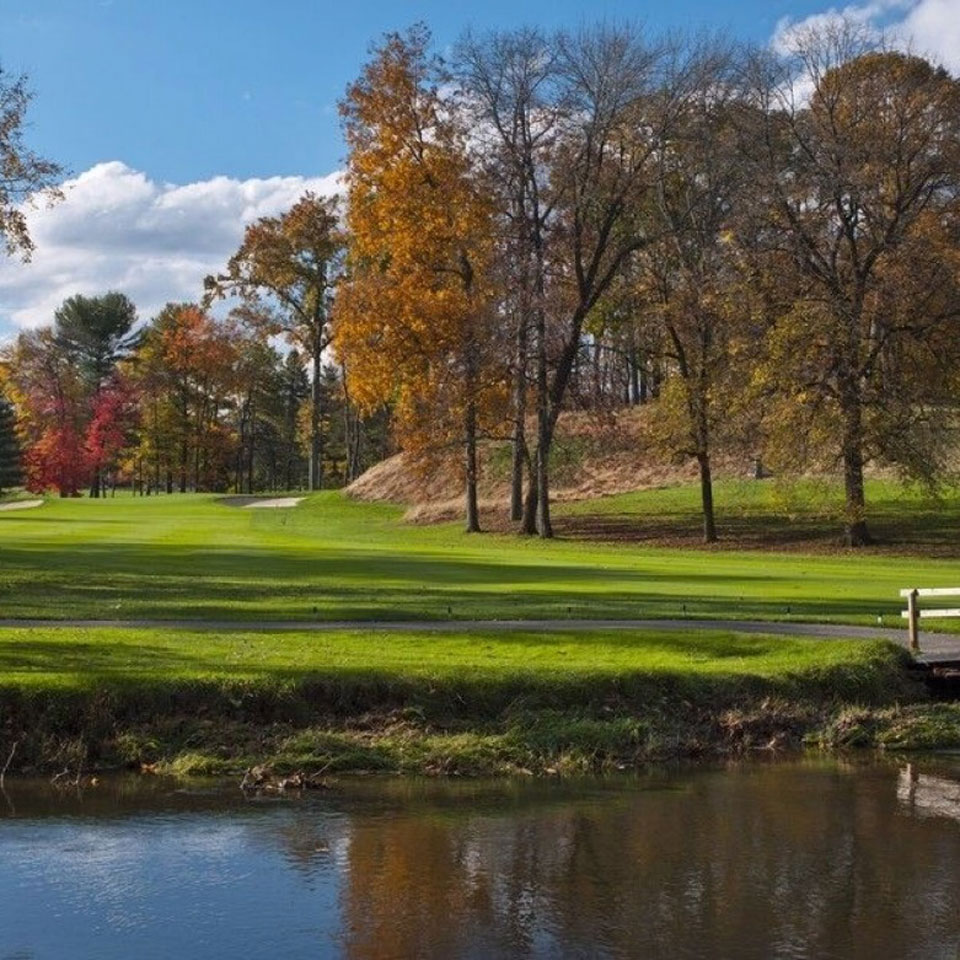
The Grace Course’s number twelve, the renovated and created Alps. Previously, the hillside on the right was littered with trees that shaded the green. The work done on this hole has dramatically improved what was previously there. Photo courtesy of Saucon Valley CC.
Hole 13: Valli Hi: This hole, along with the 10th, possesses the only sloping fairway on the Grace. A straight tee shot is required to avoid the rough on the right and the trees on the left (shared with the 10th). The tee shot should favor the left side, as it opens up the rather large, elevated green (a rarity on The Grace Course). Again, there is little imagination with this green for such a short hole. The player sees the 17th green and 18th tee on the Weyhill Course from the green.
Hole 14: Over There: This is the last of the par 3s on the Grace Course. The tee shot, with a 7 or 8 iron, is played to an amphitheater setting near the Villa Pazetti. Part of the front of this green is a false front, while the back portion is rather flat. The same thoughts I stated about hole 5 can be reiterated here to strengthen the hole. The 1980s scorecard version had this hole as the signature hole on the Grace Course.
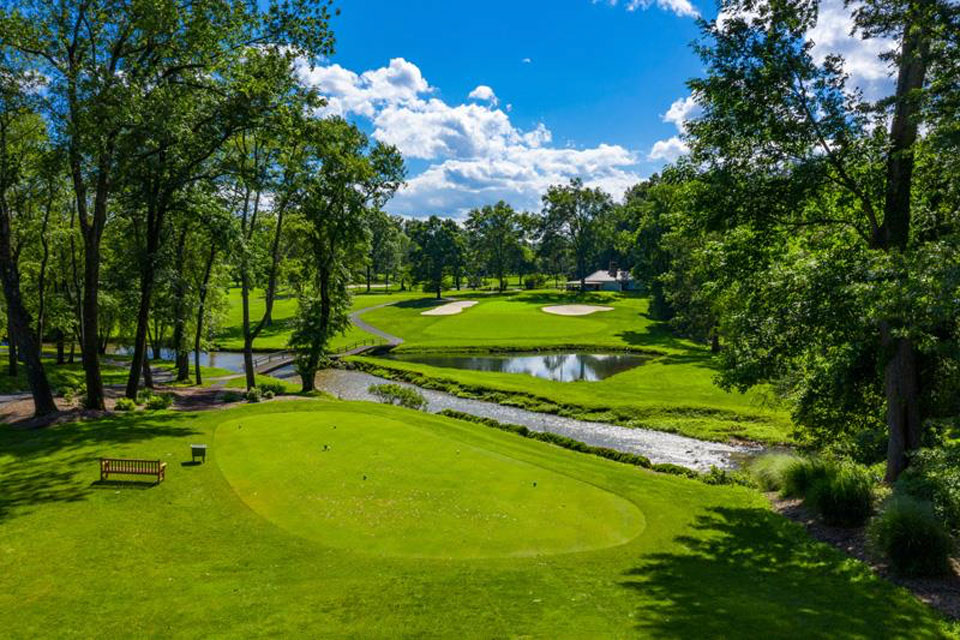
The Grace Course’s number fourteen. In the background is the Villa Pazetti. This was the photograph on the Grace Course’s scorecard in the 1980s. Photo courtesy of Saucon Valley CC.
Hole 15: Faraway: This hole was analyzed by Ron Forse in Links Magazine in either 1999 or 2000 as an example of a strategic par 5. It is a double dogleg, first to the right (and slightly uphill), then to the left, which sets up a wedge approach to a moderately sized green. While Forse is right concerning the number of options available to the player from the tee, its position on the back nine is unfortunate because a player will have hit a wedge on nos. 10, 12, and 13, and another wedge on 15 is too repetitive. As a par 4 and playing at 505 yards, the finishing stretch would be quite strong, although certainly not in the league of Winged Foot West.
Hole 16: Mounds: This hole is remarkably similar to the 16th on the Old Course with two major exceptions: (a) the tee shot on Grace 16 must be hit from left to right to avoid the trees and (b) there are mounds surrounding the green that slopes from front to back. Missing this green is usually not recommended because of the heavy rough on the mounds. A player can see the 6th green on the Old Course from this green. There is an area ten yards behind this green to create a new green venue for this hole to strengthen it.
Hole 17: Corner: This hole is the only severe dogleg from left to right on the course. The tee shot must be hit from left to right and be center-left on the fairway to open up the green. This, along with the 12th green, is the only non-original green on the Grace Course. The original allowed for a bump and run shot to a semi-punchbowl green. In the late 1980s, the green complex was changed to force a shot from the air and added some severe contours. It is the only green that looks (more or less) out of place on the entire Grace Course. I must say, however, that changing the green strengthened the hole significantly. This hole is parallel to the 8th on the Old Course.
Hole 18: Playground: This hole, after some of the heroics found on the Grace Course, is somewhat of a letdown. The hole is usually downwind and downhill. The Shoudy barn entrance road is on the player’s right (OB). The tee shot is best played right to left, which leaves about 150-160 yards to the hole. The second shot is played to a moderately sized green with some contours and some trees long and the squash court’s playground on the right (hence, the name of the hole). There is simply no room for any spectators on this hole. Hole 18 also parallels the 1st hole. From an inside and outside the ropes point of view, Hole 18 is the entire reason why a tournament will never be played on The Grace Course. I do wonder how strong this hole could be if the trees behind the back tee were removed and the tee ground be placed on the other side of the Old Philadelphia Pike to play at 485 yards.
In summary, the maximum total yardage for The Grace Course is 7,350, with a par 70 set-up at 7,250 yards.
Weyhill Course
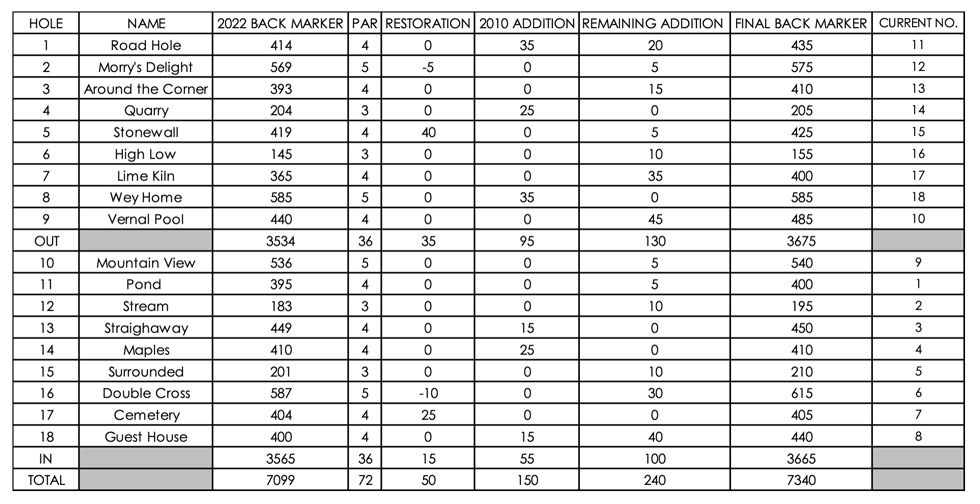
N.B. The 2010 work done restored the original back tees on holes five and seventeen. They had been previously deleted from member play from the 1980s. The original back marker yardage was 6,968 at par 72.
The Weyhill Club Course always disappointed me in the way the land was utilized by the Gordons. SVCC and Bethlehem Steel didn’t purchase the super-sized version the Gordons sold to the Stanwich Club, even though the land presented that opportunity. The greens on the Weyhill Course have much more contour than the greens on the Grace Course. Additionally, it does not appear as if they had any space limitations on what they could design. Some of the original back tees were restored, while some holes gained yardage after the 2010 renovation. The original design blueprint (last I checked) can be found in the caddyshack. As mentioned earlier, this is the only course at SVCC where the holes have only been named in the last twenty or so years. I created names myself while caddying there on a Sunday (I will include the club’s names, along with mine for comparison/contrast purposes). For the record, I find the course to be of great enjoyment to play, just disappointed with the lack of fortitude throughout the 18 holes. This course has the longest walks between holes from the original rotation (8 and 9, 10 and 11, 16 and 17(!!!) of all three courses. As part of the narration, I will go with the original hole design as established by the Gordons. You can utilize the matrix to determine where each hole falls under the current rotation.
Hole 1: Road Hole (Roadside): This hole earns its name because of the road that parallels the 1st hole on the left. The tee shot is straightforward and needs to avoid some fairway bunkers. Currently, the second shot is with a wedge to a severely contoured green from back to front. There is an area about twenty yards directly behind the green that would be great for a green site and add length to the hole for a better opening hole.
Hole 2: Morry’s Delight (Death Valley): This hole earns its name (from me) for the huge depression in the land separating the lower fairway from the upper fairway and green. I would surmise Morry Holland must have liked this hole; hence its name. As a par 5, it requires a long, drawn tee shot that sets up a long mid-iron up the hill and over Death Valley to about 105 yards from the hole. From there, it is a wedge to a large two-tier green with a front left bunker most in play. I believe placing the green at the 103-yard marker (and the same size as the current green) would make for perhaps one of the best par 4s in Pennsylvania and would be quite a heroic second shot. For years, the club had a fairway cut in Death Valley; in 1987, it was eliminated. As a par four, it would play at 510 yards and would become one of the toughest par fours in the entire Commonwealth.
Hole 3: Around the Corner (Weyhill Crescent): This hole earns its name from one of the estates near the 3d tee, as well as the view from the tee. The tee shot is best worked from left to right and towards the right side, as the fairway is sloped from right to left. The second shot is a short iron to a moderately sized green that is wildly contoured and a deep bunker on the right side. The only change I would make is pushing the fairway slightly to the left from the tee to increase the pitch in the fairway. When you are done with this hole, it is best to look over at the 5th green to see where the hole location is that day.
Hole 4: Quarry (Quarry): This hole earns its name from the quarry between tee and green. The green is pitched from back to front and from side to side. It requires a six or seven iron depending on tee marker placement. The only thing I would add is closely mown chipping areas right and long. Given the natural setting, this is the best par 3 on the course and the second-best at SVCC behind the Turtle. When the breeze kicks up, this is one hard hole. This hole was featured on the 1980s scorecard as the definitive hole on The Weyhill Course.

The Weyhill Course’s number four original location, the Quarry hole. In the quarry is the lime kiln and the back tee for number six in the original rotation. This is perhaps the most natural hole on the entire SVCC property. Photo courtesy of Saucon Valley CC.
Hole 5: Stonewall (Valley): This hole earns its name from the stonewall going up the hill towards the green and maybe the best par 4 on Weyhill. The tee shot is hit into the valley to a fairway that slopes from left to right and is about 25-30 yards wide. The second shot is straight up the hill to a hillside green strewn with bunkers and trees on the left and long (a lost ball for sure). The green has two distinct levels, although there is little contour in this green. I named it Valley because of the view from the back tee towards the fairway and the view from the green back towards the tee.
Hole 6: High Low (Hilltop): This hole earns its name because there are two back tees on this hole: One on top of the hill and another near an old fireplace almost level with Saucon Creek. The green is quite large considering the shot and not all that severe. It is also surrounded by sand. I think the hole would be best played from the fireplace location, add ten yards and increase the slope to the green given it will only be a 155-yard shot. The only problem with this change is the length of the walk from 5 green to 6 tee. This hole represents the closest I have ever come to a hole-in-one—almost holing a wedge on the fly.
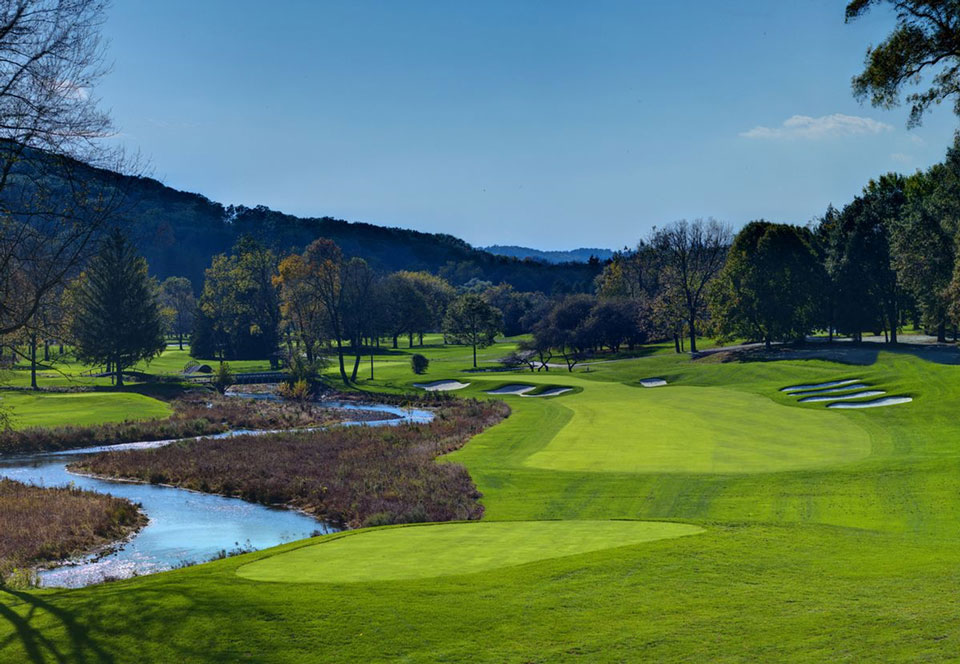
The Weyhill Course’s number six original rotation. Prior to the renovation, there were plenty of trees along Saucon Creek; thankfully, they have been removed, improving the quality of the hole. To the left would be hole thirteen original rotation. Photo courtesy of Saucon Valley CC.
Hole 7: Lime Kiln (Homestead): This hole earns its name from the lime kiln to the right of the back marker. The back tee is between two trees at the base of the hill that shapes the 6th hole. Originally, there was a stand of trees along Saucon Creek on the left, which have been eliminated so the player sees the entire creek in play. Currently, the hole is an iron/wedge to a smallish green surrounded by sand. I would push the fairway towards Saucon Creek on the left, push the green towards the creek as well, deepen some of the bunkers and increase some slope to the green. I named it Homestead because of the home right and up the hill from the green site.
Hole 8: Wey Home (Running Away): This hole earns its name because, under the current configuration, concludes one’s round on Weyhill. It is another Gordon double dog-leg par 5, but I like this one in the manner in which they utilized the land. The tee shot must be hit left to right, a long iron or wood up the hill, and a wedge third. The green is reasonably contoured with a deep bunker right front. I would add some closely mown chipping areas right and long on this hole to improve it. I named it Running Away because it always felt like it ran away from the player as you ascended the hill towards the green site.
Hole 9: Vernal Pool (Pit): This hole earns its name because of the depression of land 50 yards short and right of the green. After the long walk from the 8th green to the 9th tee (where one must cross the road leading to the club and behind the original 1st green), one must play a long tee shot (either a draw or fade works), then a mid-iron into a large, moderately contoured green with bunkers left and right. The hole works its way back to the caddyshack. There is plenty of room behind the back tee, which would add forty yards and would be consistent with the original design of the hole.
Hole 10: Mountain View (Spectacles): This hole earns its name from the view from the fairway towards the green, where one sees the mountain in the backdrop. When I caddied at SVCC, most caddies started their rounds on Weyhill at no.10 to start with a par 5. The tee shot asks for a draw, a mid-iron to set up the wedge third shot. The green has some decent size and is moderately contoured. The USGA did the right thing in 2014, converting this to play as a par four for the USGA Mid-Amateur. The back nine needed a par four over 450 yards, as well as adding a challenge to the player after hitting short irons at holes 6, 7, and 8. I named the hole Spectacles because of the two bunkers guarding the front of the green similar to that seen at Carnoustie Championship no. 14.
Hole 11: Pond (Skeet Shooting): This hole earns its name after the pond on the right of the fairway. The tee shot, especially in the morning, is played into the sun and is best played left to right to set up a short iron approach. There is a pond on the right that affects a player’s drive. The green is moderately sized and contoured. The only thing I would change is to bring Saucon Creek (on the right side of the green) more into play with the green to offer some challenge to the second shot. I named it Skeet Shooting because there was a skeet shooting facility back and to the left of the fairway and one could find spent clays littering an area between the 11th and 8th holes.
Hole 12: Stream (Creek). This hole earns its name after the creek/stream fronting the green. The tee shot is over the creek (the only par 3 with water really in play) to a severely contoured green with a bunker right and left. This hole, in the morning, plays into the sun. The only change I would make is to bring Saucon Creek more into play both in front and left. One of my favorite playing memories took place on this hole one Monday. It was playing right into the sun and 185 yards. I hit a 5-iron (Titleist 1) but couldn’t see the result. I thought I hit it thin and hit another ball. The second ball (Titleist 2) felt thin too, so I hit a third (Titleist 3) and felt the same feeling. Well, I decided to walk to the green to find out what happened. To my astonishment, all three balls were within 6 feet–the only problem was my original tee shot was 6 feet above the hole and I three-putted for a terrible bogey!
Hole 13: Straightaway (Willows): This hole earns its name because it’s as straight as an arrow. The tee box is hard against Saucon Creek. The tee shot requires a long tee shot (a draw or fade works) to reach a fairway that begins to climb uphill about 165 yards from the green. The second shot with a 7 or 8 iron must be delicately played to a smallish green surrounded by bunkers that possess some decent contours. Since there is not a real level lie in the fairway, there is an extra test for the player on the second shot. This hole looks natural in its setting. I named it Willows because of the multitude of trees on both sides of the fairway.
Hole 14: Maples (Pond): This hole earns its name because of the maples providing the boundaries of play on this hole. I believe this is the weakest hole on the course. The tee shot is with a drawn, long iron or fairway metal. The second shot is with a wedge from a level lie to a large green, pitched from back to front (although it is not that severe given the length of the second shot). I believe eliminating the pond and elevating the green site by at least ten feet would place a higher value on the second shot. I named it Pond because of the pond to the right of the green site.
Hole 15: Surrounded (Surrounded): This hole earns its name because the green is surrounded by sand. The tee is elevated to a moderate-sized green with gentle contours. A sliced iron can find Saucon Creek to the right if off-line by 15-20 yards. I would eliminate the back right bunker so shots missing the green long may find Saucon Creek. Someone took some of my advice (LOL) and eliminated several trees around the green site to increase the impact of a swirling breeze. This is one solid par three.
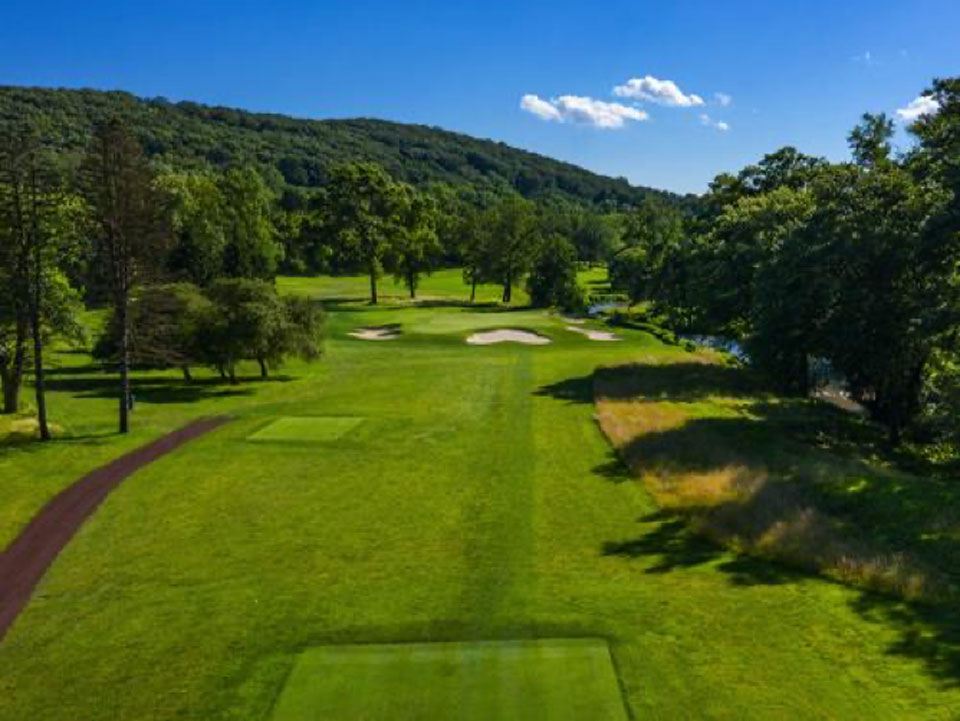
The Weyhill Course’s number fifteen original rotation. Prior to the renovation, there were far more trees protecting the green. Thankfully, a number were removed, especially along Saucon Creek. To the left would be number sixteen original rotation. Photo courtesy of Saucon Valley CC.
Hole 16: Double Cross (Double Cross): This hole earns its name because it is similar to the 10th on the Grace Course where the player must cross Saucon Creek twice. The drive must be played left to right to a similarly sloping fairway. There is a huge weeping willow at the end of the fairway on the right side. The second shot is played over Saucon Creek to a flat fairway. The third is about 100 to 120 yards over Saucon Creek again to a small green with bunkers right and left. From the green, the player can see 11 green and 12 tee on the Grace Course. I would push the tee back by a maintenance shed because one can hit a three-wood and get away with it.
Hole 17: Cemetery (Elbow): There’s a small cemetery near the back tee ground; hence the hole’s name. After you catch your breath from the walk from 16 green, the tee shot must be played left to right to an area about 150 yards from the tee and thread through two bunkers right and one left. From there it is a 9 iron or wedge slightly uphill to a distinct two-level green with no bunkers (the only hole on Weyhill without bunkers). From the green, the player can see the 13th on the Grace Course. I named it Elbow because of the extreme dogleg and similar to that at TCC Brookline no. 17.
Hole 18: Guest House (Verandah): This hole earns its name because the Guest House overlooks the green to the right. The elevated tee shot must clear Saucon Creek and move left to right. From an area about 130-150 yards out, it is a wedge to a green with a mound in front and bunkers left and right. The green is not all that severe. For a finishing hole, this is incredibly weak. I would eliminate the current green and place a new somewhat elevated one back and to the left forty yards near a bend in Saucon Creek so a wedge is no longer hit into the 18th hole. The fairway would also have to be recontoured to play correctly. I would surmise the 2010 work must have addressed the fairway flooding issues, as that was a distinct problem in the 1980s and 1990s.
In summary, the maximum total yardage for The Weyhill Course is 7,340, with a par 70 set-up at 7,240 yards.
—–
Well, I hope this narrative description will answer any questions about SVCC and remains more than reasonably complete in all material respects. If you have any further questions, please feel free to email me (jbr9693@aol.com).
The End







